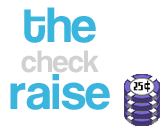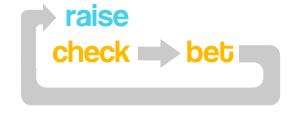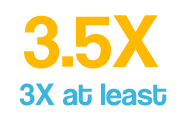The Check Raise
Further Strategy: Tight Aggressive : Continuation Bet : Check Raising : Float Play : Stack Sizes : Relative Position

Seeing as it is quite possibly the most powerful move in poker, you really don't want to leave the check raise on the sideline when you sit down at the poker table.
It isn't difficult, nor is it complex, yet it is a move that can win you some very nice pots if it is employed successfully. So lets learn what this check raise is all about then shall we?
What is the check raise?
A check raise is essentially where you check when the action reaches you, with the intention of reraising any player that decides to make a bet after you have checked.
It shouldn't be too difficult to figure out in your head, but let me give you an example anyway...
Let's say you are playing $1/$2 heads up NL Texas Holdem with an opponent and you are first to act on the flop. You decide to check, and then your opponent makes a standard bet of $10. The action is back on you, but instead of calling or folding, you come over the top making a $35 raise. I bet you didn't think of doing that before did you? This is called a check raise.

Why is the check raise effective?
The check raise is effective because it is a show of great strength, and in addition to this it 'traps' your opponent's money in the pot.
At first you are showing weakness by checking, and so your opponent decides to be the aggressor in the hand by betting out. However, you turn the hand on its head by showing no fear of your opponent's bet whatsoever by coming in over the top with a strong raise, which is sure to set alarm bells ringing and force your opponent to take a step back for a second.
Your opponent has now had their money 'trapped' in the pot because they will now have to call your raise to see the next card, which is something that they didn't expect to happen when they decided to bet out. Furthermore, your show of strength means that they are going to have a very hard time calling this raise unless they have a very strong hand, and so the likelihood is that they will fold.
How to make a successful check raise.
Aside from having to be the first to act to be able to use the move, the two primary features of a successful check raise are the size of the raise and the situation in which the check raise is used.
1] Make sure your check-raise is big enough. Don't be feeble.
Firstly, when you make your raise you want to make sure that you are raising enough so that you force your opponent to  make a tough decision. If you make a minimum raise or a raise that is a little too small, your opponent will feel compelled to call and your check raise will have lost its venom.
make a tough decision. If you make a minimum raise or a raise that is a little too small, your opponent will feel compelled to call and your check raise will have lost its venom.
As a general rule, I will usually make my check raises around 3.5 times the size of my opponent's bet. So if they bet $10, I am going to raise $35. I would rarely (if ever) consider making a check raise of less than 3 times the size of the initial bet.
2] Check raising with monster hands is not always best.
Secondly, you want to make your check raises when you want to take down the pot before the hand develops any further. So whether you are bluffing or trying to protect your hand from future rounds, the idea is that you want to make your opponent fold so that you can avoid playing on further streets.
So if you have a monster hand, you do not really want to be making a strong move like a check raise, as there is a good chance that it will cut off your action and prevent you from making money on the next few betting rounds.
When not to check raise.
As I have mentioned, there is no need to check raise when you have a monster hand. With a very strong hand, you want to get as much money into the pot without scaring your opponent(s) away, so the best plan of attack in this instance will be to slow play your hand rather than check raising and throwing your weight around. With a check raise you are trying to stop the action, which is the opposite of what you want to do with a strong hand.
The check-raise is not magic. It will not magically help you to win bigger pots when you have the best and get your opponent off the best hand when you are bluffing. Have a good think before using it.
You should not attempt a check raise if your opponent is passive, or if you feel that they are not going to bet out after you have checked to them. By checking to such a player, you are risking giving them a free card, which could turn out to be very costly. If you want to protect your hand against this type of player, you are better off betting out off the bat rather than trying to get tricky with a check raise.
Check raise overview.
Check raising is a deceptive and effective play, and your opponents are not going to like you for using it. In my standard game, I do not utilize the check raise too often, as I normally prefer to bet out rather than risk giving my opponent a free card in a failed check raise attempt.
However, from time to time I will use the check raise, but this is more often than not going to be when I am semi-bluffing when playing a flush or straight draw.
If you want to go out and start getting to grips with the check raise, be sure to pick your spots carefully. The check raise can prove to be very costly if things do not go your way, so take your time and use it sparsely, or prepare to lose a bit of money whilst you learn how to use the check raise properly.
Go back to the sublime Texas Hold'em guide.
Can You Afford Not To Use
Poker Tracker 4?
“I wouldn’t play another session of online poker without it”
“I play $25NL, and in under 1 week PT4 had paid for itself”
Comments

